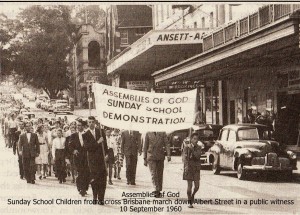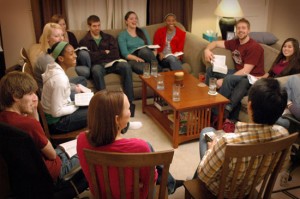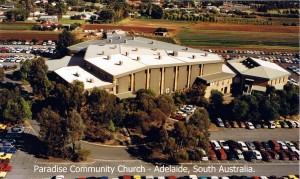Church Models
by Elizabeth Evans
 I have been adding my two pence worth to Fred’s Old Codgers on this debate and have enjoyed the interaction from the respondents. Fred suggested I put my thoughts down in print and so I am, just for fun! I have the benefit of living through quite a few church models in our church movement, albeit with eyes from the sidelines and predominately in Queensland.
I have been adding my two pence worth to Fred’s Old Codgers on this debate and have enjoyed the interaction from the respondents. Fred suggested I put my thoughts down in print and so I am, just for fun! I have the benefit of living through quite a few church models in our church movement, albeit with eyes from the sidelines and predominately in Queensland.
Pioneering Model
I was born into the initial pioneering model that was, largely speaking, personal evangelism from wildly devoted people who having experienced the Pentecostal experience were driven to share Jesus, the Saviour, Healer, Baptiser and soon Coming King.
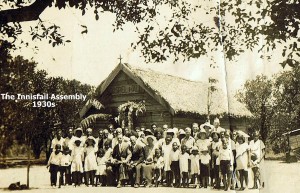
A hallmark of many early conversions was divine healing. The ministry was deeply sacrificial, with reliance on God for basic daily needs. The adherents were not mean, but their giving was generous to the buying property, and building small churches in their communities. The Assemblies of God, as it took shape, was a despised, persecuted and demon possessed movement in the eyes of the wider church communities.
As I remember, the church model changed dramatically in the 50s. Child Evangelism was a priority. Every Sunday morning cars and busses traversed the streets piling in children who were brought in to Sunday school. Child evangelism training was a prominent feature. Interposed with Sunday was the Friday night Royal Rangers, which saw children and families from un-churched backgrounds, come to know Christ and become the nucleus for the planting of new churches. These new groups were called daughter churches and were largely financed from the mother church (a year or two) until they were financially able to become autonomous and self-supporting.
The 70s ushered in a new model of the Small Groups. Small groups in homes became necessary because of the rapid church growth of the Charismatic move. Home group leader training was a priority. Many new adherents were churched people from other denominations. They came because of the wave of love and joy that permeated our services in singing Scripture in song and dancing in joyful worship.
Rapid church growth ushered in a few Mega Churches, social acceptance, and goodwill in the wider church community. At last, the Assemblies of God was no longer a weird people! Then we changed our name!
Contemporary Church Model
The Contemporary Church model followed. It rose out of a mighty move among young people, the catalyst being the hugely successful Youth Alive rallies and the phenomena of Hillsong. The emphases were highly skilled contempory Christian musicians and songsters. The worship found its centrality in the worship team on the pulpit.
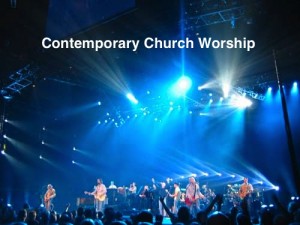
The praise and worship became central, as emphasized by the display of electronic instruments and sound systems on our platforms. Motivational preaching is a feature. The piano, organ, hymnal, floral arrangements, testimony, scripture reading, items, tongues, interpretation, and prophetic messages in church, are, largely speaking, given up, as were the featured icons of Christianity such as the symbol of the cross and the centrality of the communion table. To some degree, the Lord’s Table in our services is sidelined, and a pre offering exhortation is often an addition.
Campus Model
So all that preamble has brought me to the discussion on the newish Campus Model.As I have said my observation is from the sideline, and as I see it, it is at the early stages of the mushrooming. Empirically it seems successful for the campuses involved.

Mega churches (and others) have been able to come into struggling churches and provide support in finance, personal, and brand. As far as I can see, for the churches involved, the results are positive.
I am only aware of one instance where the young pastor felt ready to take his campus into autonomy and the denial resulted in devastation to him personally, and his entire family. The campus no longer exists but some members have been fed into another campus. Autonomy, not central government has been the flagship of the Assemblies of God in Australia, and perhaps a campus model is now sometimes required in the present financial climate that necessities reasonable wages for ministry staff.
I therefore humbly like to suggest some possible pit falls in this model.
- Firstly I consider the power and control issue and the possible risk of pride that could pervade the top of this tree. There is enormous responsibility maybe more than one should carry for full-orbed health, especially for the micro manager.
- There is also the matter of competitiveness, which has the possibility of setting brother against brother. There could be them and us develop among church leaders.
- There can be imbalance in decision-making at Conference level with policy issues when Multi Campus leaders can direct the whole team to vote en mass.
- I think Presidents must be at pains to please campus leaders as there could be a threat to take my bat and leave! (I have not seen a study of the statistics of new church plants in recent years so cannot quantify the campus success for new church planting. Perhaps some informed person can add this rating for our interest.)
- The campus model could perhaps tell on the development of the next wave of leaders. As a campus leader, they do not have the necessity to train in faith-prayer for God’s blessing to succeed. They do not learn skill in responsibility for money matters, or waiting on God for vision for the church, and personal growth through responsibility of leadership. This must be a very frustrating situation for an ambitious young leader.
- Considering the congregations involved in a campus takeover, mostly I would say they are happy to see the revival of their churches, and when people are coming forward to receive Christ one cannot be unhappy.
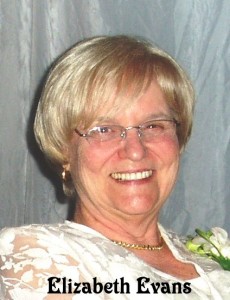 However, there is a trail of unhappiness from people who have sown their whole lives in service and finances in a church only to have their role in church life cast aside by people who have sown nothing into the church.I am sure this can be avoided by Godly wisdom.
However, there is a trail of unhappiness from people who have sown their whole lives in service and finances in a church only to have their role in church life cast aside by people who have sown nothing into the church.I am sure this can be avoided by Godly wisdom.
- Finally the answer to the question of what happens when the Mega Leader retires, or falls spiritually, or becomes sick is yet to be answered in the campus model. I guess succession plans are in place.
As I see it, so far so good, and by God’s grace we believe that it will continue to be so.

